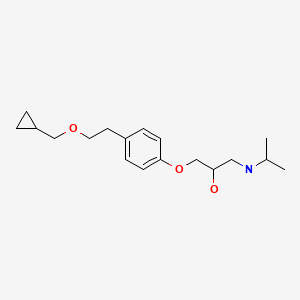Attribution Statement: LactMed is a registered trademark of the U.S. Department of Health and Human Services.
NCBI Bookshelf. A service of the National Library of Medicine, National Institutes of Health.
Drugs and Lactation Database (LactMed®) [Internet]. Bethesda (MD): National Institute of Child Health and Human Development; 2006-.
CASRN: 63659-18-7

Drug Levels and Effects
Summary of Use during Lactation
Because of its relatively extensive excretion into breastmilk and minimal reported experience during breastfeeding, other beta-blocking agents may be preferred for systemic use, especially while nursing a newborn or preterm infant.
Ophthalmic use of betaxolol by the mother should pose little risk to the breastfed infant, although some guidelines state that gel formulations are preferred over solutions.[1,2] To substantially diminish the amount of drug that reaches the breastmilk after using eye drops, place pressure over the tear duct by the corner of the eye for 1 minute or more, then remove the excess solution with an absorbent tissue.
Drug Levels
The excretion of beta-adrenergic blocking drugs into breastmilk is largely determined by their protein binding. Those with low binding are more extensively excreted into breastmilk.[3] Accumulation of the drugs in the infant is related to the fraction excreted in urine. With 50% protein binding, 15% renal excretion and a long half-life, betaxolol presents a moderate risk for accumulation in infants, especially neonates.
Maternal Levels. Three mothers who received 10 mg of betaxolol orally before delivering their infant had postpartum colostrum betaxolol levels measured. In one woman who had one dose 3 hours prior to delivery, colostrum levels were 48 mcg/L 24 hours postpartum, 13 mcg/L 48 hours postpartum and 3 mcg/L 72 hours postpartum. Another woman who received a dose 25 hours before delivery had milk levels of 8.8 and 7 mcg/L 48 and 72 hours postpartum, respectively. A third woman who had a dose 26 hours before delivery had colostrum betaxolol levels of 7.8 and 4.2 mcg/L 24 and 48 hours postpartum, respectively. Each of these women had received only 1 or 2 doses of betaxolol before delivery, so steady state might not have been reached.[4]
Infant Levels. Relevant published information was not found as of the revision date.
Effects in Breastfed Infants
A study of mothers taking beta-blockers during nursing found a numerically, but not statistically significant increased number of adverse reactions in those taking any beta-blocker. Although the ages of infants were matched to control infants, the ages of the affected infants were not stated. None of the mothers were taking betaxolol.[5]
Beta-adrenergic blocking drugs with breastmilk excretion characteristics similar to betaxolol have caused adverse effects in breastfed newborns.[6,7]
Effects on Lactation and Breastmilk
Relevant published information on the effects of beta-blockade or betaxolol during normal lactation was not found as of the revision date. A study in 6 patients with hyperprolactinemia and galactorrhea found no changes in serum prolactin levels following beta-adrenergic blockade with propranolol.[8]
Alternate Drugs to Consider
(Systemic) Propranolol, Labetalol, Metoprolol; (Ophthalmic) Levobunolol, Metipranolol, Timolol
References
- 1.
- Belkin A, Chen T, DeOliveria AR, et al. A practical guide to the pregnant and breastfeeding patient with glaucoma. Ophthalmol Glaucoma. 2020;3:79–89. [PubMed: 32672600]
- 2.
- Blumen-Ohana E, Sellem E. J Fr Ophtalmol. 2020;43:63–6. [Pregnancy & glaucoma: SFO-SFG recommendations] [PubMed: 31813552]
- 3.
- Riant P, Urien S, Albengres E, et al. High plasma protein binding as a parameter in the selection of betablockers for lactating women. Biochem Pharmacol. 1986;35:4579–81. [PubMed: 2878668]
- 4.
- Morselli PL, Boutroy MJ, Bianchetti G, et al. Placental transfer and perinatal pharmacokinetics of betaxolol. Eur J Clin Pharmacol. 1990;38:477–83. [PubMed: 2379532]
- 5.
- Ho TK, Moretti ME, Schaeffer JK, et al. Maternal beta-blocker usage and breast feeding in the neonate. Pediatr Res. 1999;45(4, pt. 2):67A–Abstract 385. [CrossRef]
- 6.
- Boutroy MJ, Bianchetti G, Dubruc C, et al. To nurse when receiving acebutolol: Is it dangerous for the neonate? Eur J Clin Pharmacol. 1986;30:737–9. [PubMed: 3770068]
- 7.
- Schimmel MS, Eidelman AI, Wilschanski MA, et al. Toxic effects of atenolol consumed during breast feeding. J Pediatr. 1989;114:476–8. [PubMed: 2921694]
- 8.
- Board JA, Fierro RJ, Wasserman AJ, et al. Effects of alpha- and beta-adrenergic blocking agents on serum prolactin levels in women with hyperprolactinemia and galactorrhea. Am J Obstet Gynecol. 1977;127:285–7. [PubMed: 556882]
Substance Identification
Substance Name
Betaxolol
CAS Registry Number
63659-18-7
Drug Class
Breast Feeding
Antihypertensive Agents
Adrenergic Beta-Antagonists
Antiglaucoma Agents
Antiarrhythmics
Disclaimer: Information presented in this database is not meant as a substitute for professional judgment. You should consult your healthcare provider for breastfeeding advice related to your particular situation. The U.S. government does not warrant or assume any liability or responsibility for the accuracy or completeness of the information on this Site.
- User and Medical Advice Disclaimer
- Drugs and Lactation Database (LactMed) - Record Format
- LactMed - Database Creation and Peer Review Process
- Fact Sheet. Drugs and Lactation Database (LactMed)
- Drugs and Lactation Database (LactMed) - Glossary
- LactMed Selected References
- Drugs and Lactation Database (LactMed) - About Dietary Supplements
- Breastfeeding Links
- PubChem SubstanceRelated PubChem Substances
- PubMedLinks to PubMed
- Review Timolol.[Drugs and Lactation Database (...]Review Timolol.. Drugs and Lactation Database (LactMed®). 2006
- Review Metipranolol.[Drugs and Lactation Database (...]Review Metipranolol.. Drugs and Lactation Database (LactMed®). 2006
- Review Levobunolol.[Drugs and Lactation Database (...]Review Levobunolol.. Drugs and Lactation Database (LactMed®). 2006
- Review Diclofenac.[Drugs and Lactation Database (...]Review Diclofenac.. Drugs and Lactation Database (LactMed®). 2006
- Review Dorzolamide.[Drugs and Lactation Database (...]Review Dorzolamide.. Drugs and Lactation Database (LactMed®). 2006
- Betaxolol - Drugs and Lactation Database (LactMed®)Betaxolol - Drugs and Lactation Database (LactMed®)
Your browsing activity is empty.
Activity recording is turned off.
See more...
